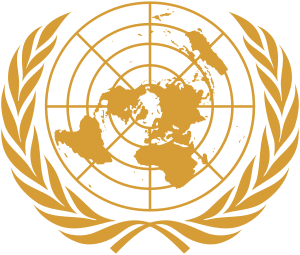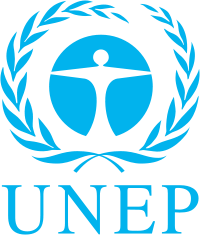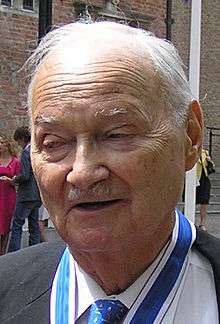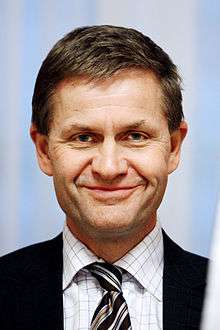United Nations Environment Programme
The United Nations Environment Programme (UNEP or UN Environment[1]) is responsible for coordinating the UN's environmental activities and assisting developing countries in implementing environmentally sound policies and practices. [2]
 | |
 | |
| Abbreviation | UN Environment UNEP |
|---|---|
| Formation | 5 June 1972 |
| Type | Programme |
| Legal status | Active |
| Headquarters | Nairobi, |
Executive Director | Inger Andersen since 2019 |
Parent organization | United Nations |
| Website | www.unenvironment.org/ |
UNEP was founded in 1972 by Canadian businessman and philanthropist Maurice Strong, its first director, following the United Nations Conference on the Human Environment (Stockholm Conference). Its mandate covers a wide range of areas, including the atmosphere, marine and terrestrial ecosystems, environmental governance, and green economic development. UNEP's activities include developing international environmental conventions; promoting environmental science and information; working with public and private stakeholders on developing and implementing policy; funding and implementing environmental development projects, such as reforestation and wetlands restoration; and formulating guidelines on issues such as the international trade in potentially harmful chemicals, transboundary air pollution, and contamination of international waterways. It also maintains a repository of scientific and environmental research.[3]
As a member of the United Nations Development Group, UNEP aims to help the world meet the 17 Sustainable Development Goals.[4] Over the last thirty years, it has increasingly focused on climate change, helping create or implement environmental treaties and institutions, such as the UN Framework Convention on Climate Change. In 1988, it joined the World Meteorological Organization to establish the Intergovernmental Panel on Climate Change (IPCC), a leading authority on the science of climate change and options for adaptation and mitigation. UNEP is also one of several "Implementing Agencies" for the Global Environment Facility (GEF), the Multilateral Fund for the Implementation of the Montreal Protocol, and the International Cyanide Management Code.
As a programme of the United Nations, UN Environment is funded solely by voluntary contributions.
History
In the 1970s, the need for environmental governance at a global level was not universally accepted, particularly by developing nations. Some argued that environmental concerns were not a priority for nations in poverty. The leadership and of Canadian diplomat Maurice Strong convinced many of the developing nations' governments that they needed to prioritize this issue. In the words of Nigerian professor Adebayo Adedeji, "Mr. Strong, through the sincerity of his advocacy, soon made it clear that all of us, irrespective of the stage of our development, have a large stake in the matter."[5]
The need of the developing laws such as the International Labour Organization(ILO), the Food and Agriculture Organization(FAO), and the World Health Organization(WHO), led to the 1972 United Nations Conference on the Human Environment (the Stockholm Conference) to tackle the pollution caused by the industrial revolution during the 1960s and 1970s. In this conference, various topics including marine life, protection of resources, environment change, disasters related to nature, and biological change were discussed. This conference resulted in a Declaration on the Human Environment (Stockholm Declaration) and the establishment of an environmental management body, which later was named United Nations Environment Program(UNEP). UNEP was established by General Assembly Resolution 2997.[6] Headquarters were established in Nairobi, Kenya with a staff of 300, including 100 professionals in a variety of fields, and with a five-year fund of more than US$100 million.[7] At the time, US$40 million were pledged by The United States and the remainder by 50 other nations. The Voluntary Indicative Scale of Contribution (VISC) established in 2002 has the role to increase the supporters of the UNEP.[8] The finances related to all programs of UNEP is voluntarily contributed by U.N. member states. The Environmental Fund, which all nations of UNEP invest in, is the core source of UNEP’ s programs.[6] Between 1974 and 1986 UNEP produced more than 200 technical guidelines or manuals on environment including forest and water management, pest control, pollution monitoring, the relationship between chemical use and health, and management of industry.[9]
The location of the headquarters proved to be a major controversy, with developed countries preferring Geneva, where several other UN offices are based, while developing countries preferred Nairobi, as that would be the first international organization headquartered in the Global South. At first, Mexico City, New Delhi, and Cairo were also competing to the organization, but they pulled out to support Nairobi in an act of "Third World solidarity". [5] Many of the developing countries were "not particularly supportive of creating a new formal institution for environmental governance," but supported its creation as an act of "Southern solidarity".[10] The location of UNEP in Nairobi was taken as "an explicitly political decision."[5]
Governance
Executive Director
Inger Andersen was appointed Executive Director of UNEP by UN Secretary-General António Guterres in February 2019.[11] UNEP's former acting Executive Director Joyce Msuya took office in November 2018, following the resignation of Erik Solheim. Prior to that appointment, she was UNEP's Deputy Executive Director.[12]
In December 1972, the UN General Assembly unanimously elected Maurice Strong to be the first head of UN Environment. Also Secretary General of both the 1972 United Nations Conference on the Human Environment, which launched the world environment movement, and the 1992 Earth Summit, Strong has played a critical role in globalizing the environmental movement.
The position was then held for 17 years (1975–1992) by Dr. Mostafa Kamal Tolba, who was instrumental in bringing environmental considerations to the forefront of global thinking and action. Under his leadership, UN Environment's most widely acclaimed success—the historic 1987 agreement to protect the ozone layer—the Montreal Protocol was negotiated. He was succeeded by Elizabeth Dowdeswell (1992–1998), Klaus Töpfer (1998–2006), Achim Steiner (2006–2016), and Erik Solheim (2016–2018).
List of executive directors
| # | Picture | Name (birth–death) |
Nationality | Took office | Left office |
|---|---|---|---|---|---|
| 1 |  | Maurice Strong[13] (1929-2015) | 1972 | 1975 | |
| 2 |  | Mostafa Kamal Tolba (1922-2016) | 1975 | 1992 | |
| 3 | .jpg) | Elizabeth Dowdeswell (born 1944) | 1992 | 1998 | |
| 4 | .jpg) | Klaus Töpfer (born 1938) | 1998 | 2006 | |
| 5 |  | Achim Steiner (born 1961) | 2006 | 2016 | |
| 6 |  | Erik Solheim (born 1955) | 2016 | 2018 | |
| 7 | Joyce Msuya
(acting) |
2018 | 2019 | ||
| 8 | .jpg) | Inger Andersen[14] (born 1958) | 2019 | Present |
Environment Assembly
The United Nations Environment Assembly is UNEP's governing body. Created in June 2012 to replace the Governing Council, it currently has 193 members and meets every two years.[15]
Structure
UNEP's structure includes eight substantive Divisions:[16]
- Science Division:- It provides timely, scientifically credible, policy-relevant environmental assessments, data and information for decision-making and action planning for sustainable development. It monitors, analyses and reports on the state of the global environment, assessing policies and trends and providing early warning of emerging environmental threats. It spearheads UN-wide monitoring and reporting on the environmental dimension of the 2030 Agenda and SDGs.
- Policy and Programme Division:- It consolidates the policy, programme, monitoring, gender and social safeguards functions of UNEP as well as its engagement with the United Nations system and key global processes such as the 2030 Agenda. The Division ensures coherence and coordination at the strategic, policy and programmatic levels.
- Ecosystems Division:- Ecosystems Division supports countries in conserving, restoring and sustainably managing their terrestrial, freshwater and marine ecosystems, the biodiversity they contain and the products and services they provide for human well-being and prosperity. It addresses the environmental causes and consequences of disasters and conflicts. It helps countries reduce pollution from land-based activities, increase resilience to climate change and reflect linkages between poverty and the environment in their development planning.
- Economy Division:- Economy Division provides solutions for economic decision-makers and helps change the business environment by offering platforms for dialogue and cooperation, innovative policy options, pilot projects and creative market mechanisms. It works through three main branches: Chemicals and Health; Energy and Climate and Resources and Markets.
- Governance Affairs Office:- Governance Affairs Office assists Member States, major groups and relevant stakeholders, such as the private sector, to engage with UNEP's work. The Office services UNEP’s governing body, the United Nations Environment Assembly, and its subsidiary organ, the Committee of Permanent Representatives, and manages their meetings. It helps strengthen the visibility, authority and impact of the Assembly as the authoritative voice on the environment.
- Law Division:- Law Division leads the international community in the progressive development of environmental law through the promotion of capacities, transparency and accountability in judiciaries, legislatures and policy making institutions. Working directly with countries to combat environmental crime and to meet international environmental commitments, the law division improves cooperation between law makers the world over who are seeking to safeguard the environment.
- Communication Division:- Communication Division develops and disseminates United Nations Environment Programme (UNEP)'s core messages. It delivers them to governments and citizens, stakeholders and partners, including the media, through the full range of digital and traditional channels. The division advocates for environmental causes, engages the public including young people, and seeks to influence policy and practice on issues from pollution to green finance. It promotes and safeguards UN Environment's identity.
- Corporate Services Division:- Corporate Services Division safeguards UNEP’s corporate interests by providing it with tools and plans for efficient and effective management and by managing its exposure to risk. It does so in line with the core values of the United Nations as well as all other relevant rules, regulations and accountability requirements.
Activities
UNEP's main activities are related to:[17]
- climate change
- including the Territorial Approach to Climate Change (TACC)
- disasters and conflicts
- Disasters and Conflicts UNEP has endeavored to lighten the influence of emergencies or natural disasters on human health and to prepare for future disasters. It contributes to the reduction of the origin of disasters by controlling the balance of ecosystems and actively support Sendai Framework for Disaster Risk Reduction which aims to reduce the risk of disasters(DRR). As well as preventing natural disasters, the UNEP supports countries such as to make laws or policies which protect the countries from getting serious damage by disasters. Since 1999 it has helped 40 countries to recover from the effect of disasters.[18]
- ecosystem management
- environmental governance
- environment under review
- UNEP provides information and data on the global environment to stakeholders including governments, non-governmental organizations and the public for them to engage in realizing the Sustainable Development Goals. The information which UNEP shares is based on the latest science and is collected in a proper way. This makes policy makers find reliable information effectively. Through this The Environment Outlook and the Sustainable Development Goals Indicators stakeholders can have access to information easily. In addition, the UN environment Live Platform and Online Access to Research in Environment(OARE) provide transparent information collected by UNEP.[19]
- harmful substances
- resource efficiency
Awards programs
Several awards programs have been established to recognize outstanding work in the environmental field. The Global 500 Roll of Honour was initiated in 1987 and ended in 2003. Its 2005 successor, Champions of the Earth, and a similar award, Young Champions of the Earth, are given annually to entrepreneurs, scientists, policy leaders, upcoming talent, individuals and organizations who make significant positive impacts on resources and the environment in their areas.
Notable achievements
UNEP has registered several successes, such as the 1987 Montreal Protocol for limiting emissions of gases blamed for thinning the planet's protective ozone layer, and the 2012 Minamata Convention, a treaty to limit toxic mercury.[20]
UNEP has sponsored the development of solar loan programmes, with attractive return rates, to buffer the initial deployment costs and entice consumers to consider and purchase solar PV systems. The most famous example is the solar loan programme sponsored by UN Environment helped 100,000 people finance solar power systems in India.[21] Success in India's solar programme has led to similar projects in other parts of the developing world, including Tunisia, Morocco, Indonesia and Mexico.
UNEP sponsors the Marshlands project in the Middle East. In 2001, UN Environment alerted about the destruction of the Marshlands when it released satellite images showing that 90 percent of the Marshlands had been lost. The UN Environment "support for Environmental Management of the Iraqi Marshland" began in August 2004, to manage the Marshland area in an environmentally sound manner.[22]
UN Environment has a programme for young people known as Tunza. Within this programme are other projects like the AEO for Youth.[23]
International Environmental Education Programme (1975-1995)
For two decades, UNESCO and UNEP led the International Environmental Education Programme (1975-1995), which set out a vision for, and gave practical guidance on how to mobilize education for environmental awareness. In 1976, UNESCO launched an environmental education newsletter ‘Connect’ as the official organ of the UNESCO-UNEP International Environmental Education Programme (IEEP). It served as a clearinghouse to exchange information on Environmental Education (EE) in general and to promote the aims and activities of the IEEP in particular, as well as being a network for institutions and individuals interested and active in environment education until 2007.[24]
Climate change
UNEP in 1989, 31 years ago, predicted "entire nations could be wiped off the face of the Earth by rising sea levels if the global warming trend is not reversed by the year 2000."[25][26]
UNEP in 2005, 15 years ago, predicted "50 million people could become environmental refugees by 2010, fleeing the effects of climate change."'[27]
Glaciers are shrinking at record rates and many could disappear within decades, the UN Environment Programme said on 16 March 2008. The scientists measuring the health of almost 30 glaciers around the world found that ice loss reached record levels in 2006. On average, the glaciers shrank by 4.9 feet in 2006, the most recent year for which data are available. The most severe loss was recorded at Norway's Breidalblikkbrea glacier, which shrank 10.2 feet in 2006. Glaciers lost an average of about a foot of ice a year between 1980 and 1999. But since the turn of the millennium the average loss has increased to about 20 inches.[28]
Electric vehicles
At the fifth Magdeburg Environmental Forum held from 3–4 July 2008, in Magdeburg, Germany, UN Environment and car manufacturer Daimler called for the establishment of infrastructure for electric vehicles. At this international conference, 250 high-ranking representatives from the world of politics and non-government organizations discussed solutions for future road transportation under the motto of "Sustainable Mobility–the Post-2012 CO2 Agenda".[29]
Circular economy
UN Environment is the co-chair and a founding partner (along with groups such as the Ellen MacArthur Foundation) for the Platform for Accelerating the Circular Economy, which is a public-private partnership of over 50 global organizations and governments seeking to support the rapid transition to a global Circular economy.[30]
The Regional Seas Program
The world's only legal program which was established in 1974 for the purpose of protecting the oceans and seas at the regional level. More than 143 countries participate in 18 regional programs including Caribbean Region, East Asian Seas, Eastern African Region, Mediterranean Region, North-West Pacific Region, Western Africa Region, Caspian Sea, Black Sea Region, North-East Pacific Region, Red Sea and Gulf of Aden, ROPME Sea Area, South Asian Seas, South-Easy Pacific Region, Pacific Region, Arctic Region, Antarctic Region, Baltic Sea, and North-East Atlantic Region. Each program consists of countries which share the same sea and they manage the sea at the regional level. The programs are controlled by secretariats or Regional Coordinating Units (RCUs) and Regional Activity Centers (RACs).[31] UNEP realizes the protection of the seas by promoting international and regional conventions through education and training based on the assessment of how the region is polluted and how the pollution damages human body.[32]
Reports
UNEP publishes many reports, atlases and newsletters. For instance, the fifth Global Environment Outlook (GEO-5) assessment is a comprehensive report on environment, development and human well-being, providing analysis and information for policy makers and the concerned public. One of many points in the GEO-5 warns that we are living far beyond our means. It notes that the human population is now so large that the amount of resources needed to sustain it exceeds what is available.
In June 2010, a report from UN Environment declared that a global shift towards a vegan diet was needed to save the world from hunger, fuel shortages and climate change.[33]
International years
(International) Patron of the Year of the Dolphin was H.S.H. Prince Albert II of Monaco, with Special Ambassador to the cause being Nick Carter of the Backstreet Boys musical group.[34]
- 2010 – International Year of Biodiversity
- 2011 – International Year of Forests
- 2012 – International Year for Sustainable Energy for All
- 2013 – International Year of Water Cooperation
- 2014- International Year of Family Farming,
- 2015- International Year of Light and Light-based Technologies
- 2016- International Year of Pulses
- 2017- International Year of Sustainable Tourism for Development
See international observance and list of environmental dates.)
Reform
Following the publication of Fourth Assessment Report of the Intergovernmental Panel on Climate Change (IPCC) in February 2007, the "Paris Call for Action" — read out by French President Jacques Chirac and supported by 46 countries — called for the United Nations Environment Programme to be replaced by a new and more powerful "United Nations Environment Organization (UNEO)", to be modelled on the World Health Organization. The 46 countries included the European Union nations, but notably did not include the United States, Saudi Arabia, Russia, and China, the top four emitters of greenhouse gases.[35]
In December 2012, following the Rio+20 Summit, a decision by the General Assembly of the United Nations to "strengthen and upgrade"[36] the UN Environment Programme (UN Environment) and establish universal membership of its governing body was confirmed.
Funding
2018 funds withholding
In September 2018, the Dutch government announced it would withhold $8 million in funding to UNEP until nepotism issues with regard to the head of the U.N. Environment Programme.[37] Sweden and Denmark stopped funding as well. A spokesman for the Norwegian Institute of International Affairs said the freezing of funds was probably unprecedented.[38]
See also
- 2010 Biodiversity Indicators Partnership
- Citizen Science, cleanup projects that people can take part in.
- Global Climate Observing System
- Global warming
- International Renewable Energy Agency
- Melbourne Principles
- Miss Earth Foundation
- Northwest Pacific Action Plan
- Timeline of environmental events
- UNEP GEO Data Portal
- UNEP/GRID-Arendal
- United Nations Billion Tree Campaign
- United Nations Centre for Urgent Environmental Assistance
- United Nations Environment Programme Finance Initiative
- United Nations REDD Programme
- World Conservation Monitoring Centre
- World Refrigeration Day
Sources
![]()
References
- "About UN Environment". UN Environment.
- "Funds, Programmes, Specialized Agencies and Others". www.un.org. November 18, 2014.
- "Home". UNEP Document Repository. Retrieved 3 September 2017.
- "About » UNDG at the Global Level » UNDG". United Nations Development Group. 2017. Retrieved 3 September 2017.
- Ivanova, Maria (2007-11-23). "Designing the United Nations Environment Programme: a story of compromise and confrontation". International Environmental Agreements: Politics, Law and Economics. 7 (4): 356. doi:10.1007/s10784-007-9052-4. ISSN 1567-9764.
- Mark Allan, Gray (1990). "The United Nations Environment Programme: An Assessment". Lewis & Clark Law School. 20 (2): 43–49. JSTOR 43265919.
- "New York Times New York State Poll, October 2002". 2003-04-25. doi:10.3886/icpsr03708. Cite journal requires
|journal=(help) - "Environment Fund". UN Environment. Retrieved 2019-04-22.
- "The United Environment Programme(UNEP)". Technical Centre for Agricultural and Rural Cooperation (CTA) (23): 16. 1989. JSTOR 24339600.
- Najam, Adil (2005). "Developing Countries and Global Environmental Governance: From Contestation to Participation to Engagement". International Environmental Agreements: Politics, Law and Economics. 5 (3): 309. doi:10.1007/s10784-005-3807-6. ISSN 1567-9764.
- "Secretary-General Appoints Inger Andersen of Denmark Executive Director of United Nations Environment Programme, Following Election by General Assembly | Meetings Coverage and Press Releases". www.un.org. Retrieved 2020-08-03.
- "Tanzanian appointed to head U.N. Environment Programme". AfricaNews. 21 November 2018. Retrieved 23 November 2018.
- Schrijver, Nico (2010). Development Without Destruction: The UN and Global Resource Management. United Nations Intellectual History Project Series. Bloomington, IN: Indiana University Press. p. 116. ISBN 978-0-253-22197-1.
- "UN Secretary-General appoints Inger Andersen of Denmark as Executive Director of the UN Environment".
- "UN Environment Assembly and Governing Council". UNEP. Retrieved 10 March 2019.
- Environment, U. N. (2017-10-31). "UN Environment divisions". UNEP - UN Environment Programme. Retrieved 2020-02-11.
- "United Nations Environment Programme". unep.org. November 2011. Retrieved November 17, 2011.
- "Why do disasters and conflicts matter?". UN Environment. Retrieved 2019-03-02.
- "Environment under review". UN Environment. Retrieved 2019-04-23.
- Alister Doyle (February 17, 2013 ), Reformed U.N. formula for making planet greener to get first test Reuters.
- "Solar loan programme in India".
- UN Environment Marshland project in Middle East Archived October 6, 2007, at the Wayback Machine
- "AEO-for-Youth". Archived from the original on December 23, 2011.
- Issues and trends in Education for Sustainable Development. Paris: UNESCO. 2018. pp. 26, 27. ISBN 9789231002441.
- JAMES SPIELMANN. "U.N. Predicts Disaster if Global Warming Not Checked". Associated Press. Retrieved 25 February 2019.
entire nations could be wiped off the face of the Earth by rising sea levels if the global warming trend is not reversed by the year 2000.
- "U.N. Predicts Disaster if Global Warming Not Checked". Archived from the original on 2018-10-08.
- Axel Bojanowski (18 April 2011). "UN Embarrassed by Forecast on Climate Refugees". Der Spiegel. Retrieved 13 March 2019.
In 2005, the United Nations Environment Programme (UNEP) and the United Nations University declared that 50 million people could become environmental refugees by 2010, fleeing the effects of climate change.
- "U.N.: Glaciers shrinking at record rate".
- "UNEP and Daimler Call for Infrastructure for Electric and Fuel-cell Vehicles". Climate-L.org. 4 July 2008. Archived from the original on 13 December 2009. Retrieved June 16, 2010.
- "UNEP-IRP Platform for Accelerating the Circular Economy (PACE)". Global Business Coalition. 2018-01-24. Retrieved 2019-04-17.
- "Why does working with regional seas matter?". UN Environment. Retrieved 2019-04-22.
- BLISS-GUEST, PATRICIA A., and STJEPAN KECKES (1982). "The Regional Seas Programme of UNEP" (PDF). Environmental Conservation. 9 (1): 43–49. doi:10.1017/S0376892900019494. JSTOR 44520294.CS1 maint: multiple names: authors list (link)
- Felicity Carus UN urges global move to meat and dairy-free diet, The Guardian, 2 June 2010
- Also see "Energy and Agriculture Top Resource Panel's Priority List for Sustainable 21st Century", United Nations Environment Programme (UN Environment), Brussels, 2 June 2010.
- "Pop Superstar Nick Carter to Help Wild Dolphins and Oceans". www.newswise.com.
- Doyle, Alister (2007-02-03). "46 nations call for tougher U.N. environment role". Reuters.
- Damian Carrington (27 September 2018). "Under-fire UN environment chief forced back to HQ". The Guardian. Retrieved 5 December 2018.
a spokesman for the Dutch government told the Guardian: “A planned payment of €8m will be held until Unep provides more clarity, and until it is clear that Unep is taking this matter seriously.” [...] “In relation to any notion of nepotism, I wish to clarify that my spouse was recruited to REV Ocean through an open, transparent and competitive process,” said Solheim
- Damian Carrington (25 September 2018). "Nations halt funding to UN environment programme as outcry over chief grows". The Guardian. Retrieved 5 December 2018.
the Norwegian Institute of International Affairs thinktank said he thought the freezing of funds was probably unprecedented. “There are many who don’t think Unep is functioning as it should
Further reading
- United Nations Environment Programme. "Natural Allies: UNEP and Civil Society." Nairobi: United Nations Foundation, 2004.
- Paul Berthoud, A Professional Life Narrative, 2008, worked with UNEP and offers testimony from the inside of the early years of the organization.
- Dodds, F., Strauss, M., with Strong, M., 2012, Only One Earth: The Long Road via Rio to Sustainable Development. London Earthscan
External links
| Wikimedia Commons has media related to United Nations Environment Programme. |
- United Nations Environment Programme
- UNEP Finance Initiative
- Frankfurt School – UNEP Collaborating Centre for Climate & Sustainable Energy Finance
- United Nations Environment Programme – World Conservation Monitoring Centre (UNEP-WCMC)
- UNEP-Tongji Institute of Environment for Sustainable Development
- UNEP/GRID-Europe
- UNEP GEO Data Portal
- Sindrom Kodok Pada Manusia (Indonesia Language)
- Netherlands Commission for Environmental Assessment
- UNEP Regional Seas Programme
- Resources on United Nations Environment Programme (UNEP